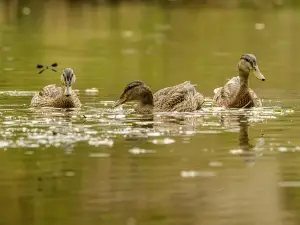
Duckbills aren’t inanimate objects, these bills are actually made up of a fleshy material on the outside and a bony structure on the inside.
The beaks can peel, can become discolored, and can rot as well. This article looks into why this happens
Table of Contents
Beak rot in ducks:
Bills are very important to ducks, these body parts help the bird eat and preen, if the bird’s bill starts having issues, and the bird can’t preen or eat, then problems can arise.
If your bird’s beak seems to be rotting then the bird likely has a sickness called psittacine beak and feather disease or PBFD.
What is PBFD?
PBFD is a condition that can affect a variety of birds including macaws, African greats, parrots, cockatiels, cockatoos, rosellas, and ducks to make a few, it is caused by the circovirus
Once the circovirus gets into your bird’s body it attaches itself to the cells of the bird’s feathers and beak killing the cells and causing your bird’s beak to look as though it is rotting.
The ailment also weakens the bird’s immune system. A bird with this ailment will be more at risk of suffering from infections because its immune system is so impaired. Infections that the bird would otherwise be able to fight off.
These other minor infections will eventually end up killing the bird because it is chronically immunosuppressed
How do birds get PBFD?
The virus that causes PBFD is shed in the feces of birds as well as in the feather dust of infected birds.
This virus can enter through the bird’s nasal passages, oral cavity, and in the bird’s cloaca through infected feather dust via inhalation or ingestion of the virus
This feather dust can also contaminate water, food, clothing, and the environment that the birds live in.
Symptoms of this disease:
In addition to the bird’s beak rotting, a bird suffering from this condition will also have these symptoms:
- Missing feathers
- Diarrhea
- Weight loss
- Loss of appetite
- Depression
- Feather abnormalities
- Regurgitation
Some birds will not show any symptoms, these birds will be asymptomatic but will be carriers of the disease.
Other birds may be carriers of this disease but will only show signs of having this disease if the birds become stressed. These carrier birds can still infect other birds while not showing signs of being sick themselves
Birds that don’t show symptoms of this disease may also be recently infected with this disease and will thus not show signs of being infected yet.
Symptoms of this disease can take weeks, months, or even years to show up in birds. When the symptoms show up can also be affected by how old the bird is
Some birds will not show signs of having this disease at all and will simply die out of the blue
What to do:
The bird can be screened for this virus, this is done using a blood test.
If you think that your bird has this disease, but the bird isn’t showing any symptoms, then you would need to isolate the bird for 90 days and then retest the bird.
Unfortunately, there is no known cure for this disease but vaccines for this ailment are in the pipeline
You can however give the bird a good quality of life by offering it supportive care while it tries to fight off this illness.
Supportive care includes giving the bird supplements like probiotics, vitamins, and minerals which will help boost the birds immune system
Also, ensure that the birds don’t come under stress, stress includes a lack of food, predators in the area, a change in temperature, and a change in habitat.
Keep infected birds away from healthy birds as it is very easy for birds to become infected with this disease
You would also need to quickly and effectively treat any secondary infections that the birds may develop. These infections regardless of how minor, can otherwise kill the bird if left untreated
Many of the birds that are infected with this disease will be able to fight it off, their bodies will create an immune response against the disease
FAQ:
Can duck beaks heal?
Duck beaks can heal but this is only possible if the break didn’t happen too far into the beak.
If the break happened ⅓ of the way into the beak then the beak will heal. If the break happened further into the beak then the tissue that creates the keratin, that the beak is made up of, will be damaged and won’t be able to produce keratin and heal the beak.
Can ducks feel pain in their beaks?
Ducks have nerves in their beaks and blood flow goes all the way to the tips of their beaks as well, because of this, the animals do feel pain in their beaks.
Other birds who don’t have nerves and blood flow in their beaks will not feel pain in their beaks
If you enjoyed this article then you may also be interested in other chicken related articles. Here are some articles that you may be interested in: Pigeon-Toed Duck, Bow-Legged Duckling, Callus On Duck’s Foot, Black Spots On Duck Bill, Black Spot On Duck Foot

